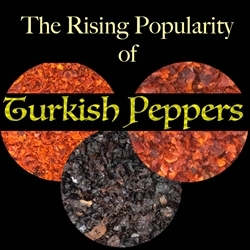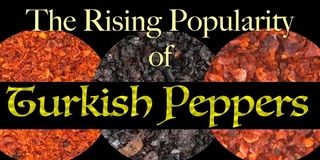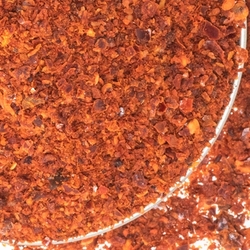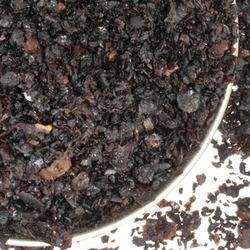The Rising Popularity of Turkish Peppers

Pepper varietals are found all over the world. We all know the Mexican chiles, like the mighty jalapeño, and are increasingly familiar with Asian chiles like Thai Bird or Tien-Tsin. What we are increasingly aware of is that Turkey, the country that bridges Europe and Asia and is one of the oldest continually-populated areas in the world, produces gorgeous peppers and has a rich, pepper-laden culinary tradition showcasing the unique flavors of their celebrated peppers. Aleppo Pepper is the most well-known pepper from this region, but there are other—bold, different, unique—peppers from this region that we love and want to celebrate.
While peppers are only indigenous to central and South America, they are easily dried and fantastically portable, so spice merchants carried them around the globe. Pepper plants tend to reproduce easily, cross-breed with other peppers near them and take on terroir characteristics that illuminate the regions in which they are cultivated; this has created the many varietals we can enjoy from all over the world. In Turkey, peppers took to the hot, dry summers and high potassium content of the soil and soon after their arrival in that part of the world were established as a viable agricultural crop. Thanks to the evolution of their glorious flavors, local peppers were easily adopted into the fabric of Turkish culture. Proud of the food grown from their land and the way their heritage has expanded to embrace these peppers, many traditional Turkish recipes eschew the use of peppercorns in favor of the peppery bite of local produce.
As interest in global cuisine has expanded in the United States, we’ve seen these three Turkish peppers—one with a caveat, that will be explained momentarily—creep steadily into menus and pantries. We’ve provided an overview of these peppers with their relative heat according to the Scoville Heat Unit (SHU) scale, and we’ve given suggestions for their use, but more detailed information is provided on their product pages.
Aleppo Pepper
2,500-5,000 SHU. Bright and tangy, this sour-salty-sweet pepper was originally cultivated in Aleppo, an ancient city located in northern Syria. Unfortunately, Aleppo has been on the front lines of a devastating civil war that has raged in Syria for nearly 10 years and has seen extraordinary loss in its people, its infrastructure, and the cultural symbols that helped define a city that’s nearly as old as civilization itself. Refugees have packed Aleppo peppers and seeds and taken them across the border into Turkey, which is less than 50 miles away. Thanks to these efforts this part of the Aleppan culture has not been lost, and the world can enjoy the Aleppo pepper’s lush, naturally oily, sweet/tart summer pomegranate-and-lemon fruitiness and back-of-the-throat heat that’s present but not overwhelming. This pepper is great for making spice rubs or for roasting on sturdy vegetables like broccoli or cauliflower, but also makes a lovely finishing oil and adds a bright pop as a garnish at the end of cooking.
Crushed Maras Chile
4,000-8,000 SHU. The Maras and the Aleppo pepper are closely related and have a similar flavor profile; both are sour, sweet, and salty, both are a bit oily by nature, and both are fruity. But the Maras (or Marash) pepper, from the Turkish city of Kahramanmaraş, has a little bit more of a complex flavor profile. When you taste a Crushed Maras Chile you’re originally greeted by its sour tang and saltiness which wakes up the palate and keeps the flavor elevated. But then a deeply earthy, cumin-like flavor takes over and turns this pepper flake into a sensory roller coaster ride. It stands up well to foods with strong flavors, like lamb, and is a welcome addition to lamb meatballs. Crushed Maras Chiles also hold up to prolonged heat, making them great for braises. Mix with labneh (thickened yogurt) and lemon for an easy spread or dip, or sprinkle Maras chiles over eggs.
Urfa Biber
6,000-8,000 SHU. This dark burgundy beauty comes from the city of Sanliurfa, and comes in dense, chewy flakes that taste smoky, raisiny, and earthy, but slightly herbaceous, and convey hints of chocolate with a touch of tobacco. The Urfa Biber's almost tannic qualities give it balance and structure and permit it to cooperate with a wide range of foods despite its deceptively deep overtones. Rich in natural oils like its aforementioned cousins, the Urfa Biber has a chewy mouthfeel that isn’t usually found in other peppers. Urfa’s smoky heat is a lovely contrast to the sweetness of fruit, so use when making fruit chutneys or compotes. It holds its own against strong meat and long cooking time; try it with game, like venison or pheasant. It’s also wonderful drizzled with oil over a hearty cheese like feta.



